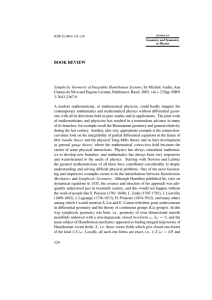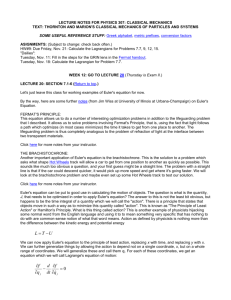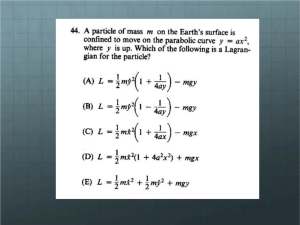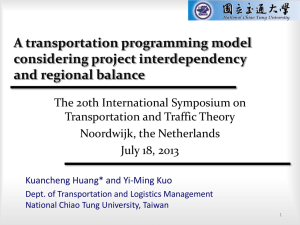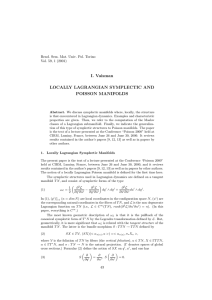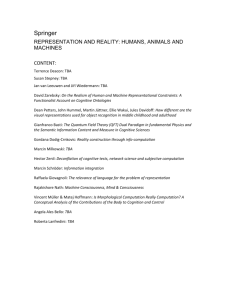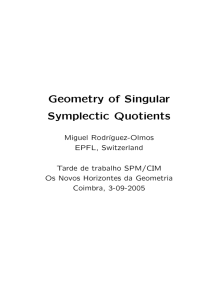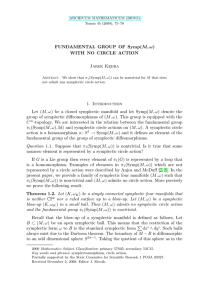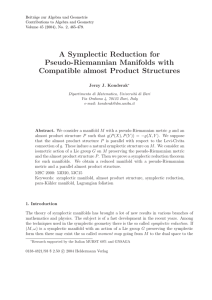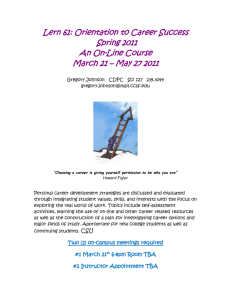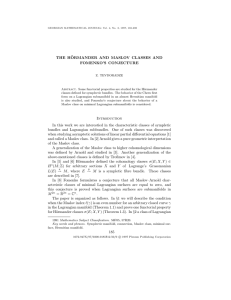DOWNLOAD TITLE and ABSTRACT
advertisement
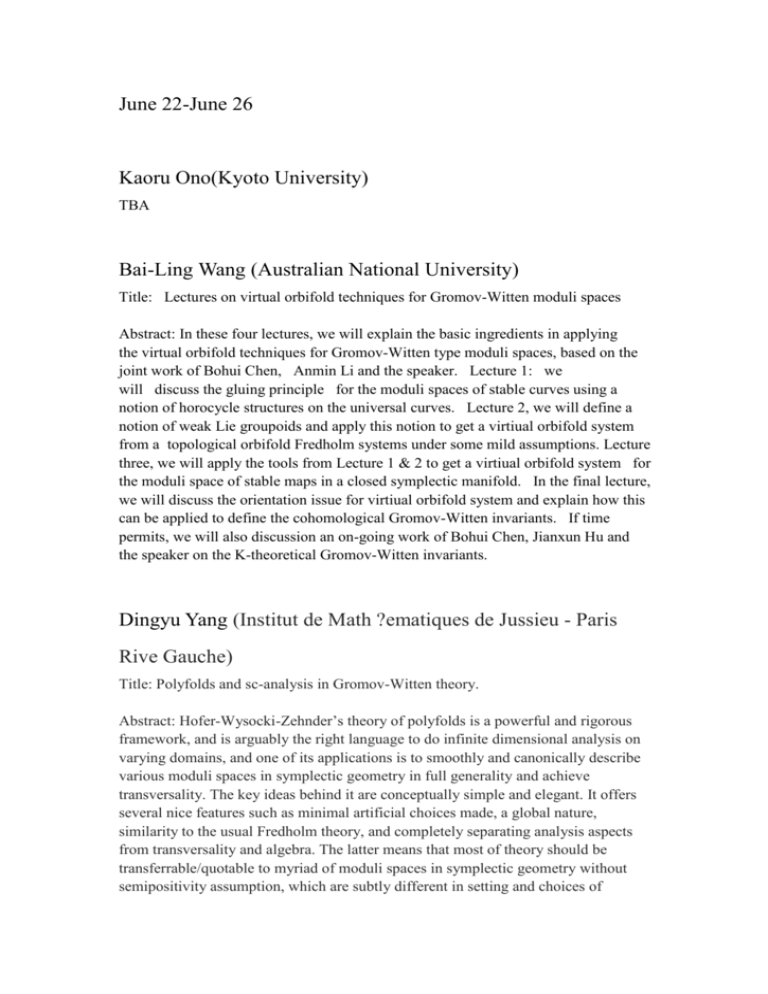
June 22-June 26
Kaoru Ono(Kyoto University)
TBA
Bai-Ling Wang (Australian National University)
Title: Lectures on virtual orbifold techniques for Gromov-Witten moduli spaces
Abstract: In these four lectures, we will explain the basic ingredients in applying
the virtual orbifold techniques for Gromov-Witten type moduli spaces, based on the
joint work of Bohui Chen, Anmin Li and the speaker. Lecture 1: we
will discuss the gluing principle for the moduli spaces of stable curves using a
notion of horocycle structures on the universal curves. Lecture 2, we will define a
notion of weak Lie groupoids and apply this notion to get a virtiual orbifold system
from a topological orbifold Fredholm systems under some mild assumptions. Lecture
three, we will apply the tools from Lecture 1 & 2 to get a virtiual orbifold system for
the moduli space of stable maps in a closed symplectic manifold. In the final lecture,
we will discuss the orientation issue for virtiual orbifold system and explain how this
can be applied to define the cohomological Gromov-Witten invariants. If time
permits, we will also discussion an on-going work of Bohui Chen, Jianxun Hu and
the speaker on the K-theoretical Gromov-Witten invariants.
Dingyu Yang (Institut de Math ?ematiques de Jussieu - Paris
Rive Gauche)
Title: Polyfolds and sc-analysis in Gromov-Witten theory.
Abstract: Hofer-Wysocki-Zehnder’s theory of polyfolds is a powerful and rigorous
framework, and is arguably the right language to do infinite dimensional analysis on
varying domains, and one of its applications is to smoothly and canonically describe
various moduli spaces in symplectic geometry in full generality and achieve
transversality. The key ideas behind it are conceptually simple and elegant. It offers
several nice features such as minimal artificial choices made, a global nature,
similarity to the usual Fredholm theory, and completely separating analysis aspects
from transversality and algebra. The latter means that most of theory should be
transferrable/quotable to myriad of moduli spaces in symplectic geometry without
semipositivity assumption, which are subtly different in setting and choices of
algebra, but share similar essential features. Polyfold theory is also compatible with
other virtual machineries. To achieve all that, polyfold theory starts with a new notion
of a smooth map, a local model and Fredholmness right off the bat. To make the
learning curve less steep, this mini course will motivate the polyfold philosophy and
get some working knowledge and illustration from Gromov-Witten theory
(http://arxiv.org/abs/1107.2097). This hopefully will demystify this particular virtual
technique, and encourage the use of polyfold as a tool to try to generalize works from
less general settings, and also provide some prerequisite for the forthcoming SFT
polyfold paper.
Bin Zhang (Sichuan University)
TBA
June 28-July 1
Kenji Fukaya(SCGP)
Title:Wehrheim - Woodward functoriality by Lekili - Lipyanskiy technique
Abstract:In this talk I will explain a way to realize the project initiated by Wehrheim
– Woodward to construct a functor from the category of symplectic manifold (with
Lagrangian correspondence as a morphism) to the category of filtered A infinity
categories. Our construction is based on Lekili - Lipyanskiy's idea in their paper Adv.
Math. 236 (2013) and uses Akaho - Joyce's Floer theory of immered Lagrangian
submanifold. Note there is another (interesting) works of this problem which is due to
Bottman-Wehrheim. Their method uses strip shrinking and figure 8 bubbles and is
different from one I will explain in this talk. (They however both are based on the
fundamental idea by Wehrheim - Woodward.)
Weiping Li (Oklahoma State University and Southwestern
Jiaotong University)
TBA
Dingyu Yang (Institut de Math ?ematiques de Jussieu - Paris
Rive Gauche)
Title: How does polyfold theory fit with other virtual techniques.
Abstract: We will take a look at the relationship of polyfold theory with some of
(hopefully all) 7 or so other proposed virtural techniques in symplectic geometry, and
hopefully provide some unity among various perspectives.
Li Guo(Rutgers University)
TBA
Huijun Fan (PKU)
Title: A mathematical theory of Gauged linear sigma model
Abstract: GLSM is an important unified theory in 2-d TFT and mirror symmetry,
which was proposed by Witten in 90's. Recently, due to the rapid development in
Landau-Ginzburg model the mathematical realization of GLSM becomes an realistic
and important program. In the past several years, Fan-Jarvis-Ruan have made some
important progress in the related moduli problem from the side of algebraic geometry
and meanwhile the side of differential geometry. In this minicourse, I will report our
progress in this direction. The minicourse will talk about the analytical theory of
GLSM and consists of the following parts:
1. Geometrical and analytical setting. (including moment map, connection theory)
2. The gauged Witten equation (Related perturbed symplectic Vortex equations
and some important examples)
3. Slice theorem, Index theorm
4. Compactness theorem.
Yoel Groman(Hebrew University)
Title:Floer theory on open manifolds
Abstract:I will discuss a recent construction which allows the definition of Floer
theoretic invariants for tame symplectic manifolds. As an application I will discuss a
computation of zeroth symplectic cohomology for the complement of an
anticanonical divisor in toric Calabi Yau manifolds. The result fits nicely with
predictions arising from mirrror symmetry.
Xiaobo Liu (PKU)
Title: Connecting the Kontsevich-Witten and Hodge tau-functions by the Virasoro
operators.
Abstract: Kontsevich-Witten tau-function and the Hodge tau-function are generating
functions for two types of intersection numbers on moduli spaces of stable curves.
Both of them are tau functions for the KP hierarchy. In this talk, I will describe how
to connect these two tau-functions by differential operators belonging to the
$\widehat{GL(\infty)}$ group. Indeed, these two tau-functions can be connected
using Virasoro operators. This proves a conjecture posted by Alexandrov. This is a
joint work with Gehao Wang.
Bai-Ling Wang (Australian National Universty)
Title: Orientifold Gromov-Witten theory
Abstract: Motivated by applying the virtual orbifold techniques to other moduli
problem, Bohui Chen and I made some progresses in the Gromov-Witten theory for
orientifolds. Orientifolds, and a genarliazed of orbifolds, have been promoted by
physicists to the study of string theory for unoriented strings. In this talk, we explain
what symplectic orientifolds are and how to establish Gromov-Witten theory on any
symplectic orientifold.
Bohan Fang(PKU)
Title:Mirror B-model for toric Calabi-Yau 3-folds
Abstract: I will discuss, by examples, the mirror curve of a toric Calabi-Yau 3-fold
(including oribfolds). In particular, I will explain the mirror curves around the large
radius limit, and the family of mirror curves over the toric variety of the secondary
fan. This is the B-model set-up in BKMP (Bouchard-Klemm-Marino-Pasquetti)
remodeling conjecture, and the understanding of the global B-model behavior is a
requirement to apply this conjecture to many interesting examples, e.g. modularity of
Gromov-Witten invariants and all genus crepant resolution conjecture.
Remark:an invitation letter (in Chinese) with dates 06/26-07/08 of my visit to
Sichuan University
Hiroshi Ohta (Nagoya University)
Title:The trace map in cyclic $A_{\infty}$ category
Abstract: Based on my joint works with K. Fukaya, Y-G. Oh, K. Ono and partially
with M. Abouzaid, I will introduce and discuss the trace map in cyclic
$A_{\infty}$ category, especially from the point of view of Frobenius manifold
structure.
Hui Ma (Tsinghua Unversity)
Title: Lagrangian intersection of the Gauss images of isoparametric hypersurfaces
Abstract: The Gauss image of an isoparametric hypersurface in the unit sphere is a
compact minimal Lagrangian submanifold embedded in the complex hyperquadric.
In this talk, we will discuss the Hamiltonian non-displaceablity of such monotone
Lagrangian submanifolds in complex hyperquadrics. The talk is based on a joint
work with Hiroshi Iriyeh, Reiko Miyaoka and Yoshihiro Ohnita.
Yong-Geun Oh (IBS, Postech)
Title: Bulk deformations, tropicalizations and non-displaceable Lagrangian toric
fibers.
Abstract: In this talk, I will first explain how we can deform Lagrangian Floer
homology by cycles from the given ambient symplectic manifold, and apply this to
Lagrangian torus fibers of toric manifolds. Then we will characterize what FOOO
call `bulk-balanced Lagrangian torus fibers' as the intersections of certain
collection of tropical curves selected purely in terms of the associated moment
polytope.
This talk is based on a joint work with Fukaya-Ohta and Ono (for the first part),
and also on the work of !
Weiwei Wu(CRM, University of Montreal)
Title: Dehn twists exact sequences through Lagrangian cobordism.
Abstract: In this talk we first introduce a new "singularity-free" approach to the proof
of Seidel's long exact sequence, including the fixed-point version. This conveniently
generalizes to Dehn twists along Lagrangian submanifolds which are rank one
symmetric spaces and their covers, including RP^n and CP^n, matching a mirror
prediction due to Huybrechts and Thomas.
Cheol-Hyun Cho (Seoul National Unversity)
TBA
Kaoru Ono (Kyoto University)
TBA
Xiaojun Chen (Sichuan University)
TBA
Wei-Ping Li (HKUST)
Title: Master Spin Fields on the Quintic.
Abstract: The Gromov-Witten invariants are essentially the counting of the number of
genus g curves in a compact complex manifold. It originated in 1990’s from the
mirror symmetry of the string theory,a physical theory trying to unit everything in
high-energy physics. The GW invariants of the qunitic, which is the zero locus of a
degree 5 homogenous polynomial of 5 variables in the four dimensional projective
space, is one of the most famous research topics from the very first day of mirror
symmetry to today. There is another physical theory for the polynomial mentioned
above, called Landau-Ginzburg theory. Physicists conjectured that these two theories
can be identified via some mysterious transformations. The mathematical foundation
of the LG-theory was established by Fan-Jarvis-Ruan, in which the invariants
analogous to GW-invariants are also defined by them and called FJRW invariants.
Master Spin Field theory is a mathematical attempt to unlock the mysterious link
between GW-invariants and FJRW-invariants. It is an on-going joint work with H.L.
Chang, J. Li and Melissa Liu.
Yi Lin (Georgia Southern University)
Title:The Hard Leschetz Property for contact manifolds
Abstract:
In the literature, there are two different versions of Hard Lefschetz theorems for a co
mpact Sasakian manifold. The first
more classical version, due to Kacimi-Alaoui, asserts that the basic cohomology of a
compact Sasakian manifold satisfies the Hard Lefschetz property. The second version
, established far more recently by Cappelletti-Montano, De Nicola, and Yudin, holds
for the De Rham cohomology of a compact Sasakian manifold. In this talk, we will di
scuss a new approach to the Hard Lefschetz theorem for Sasakian manifolds using th
e formalism of odd dimensional symplectic geometry. It leads to a Hard Lefschetz t
heorem for
the more general $K$-contact manifolds, which immediately implies that the two exis
ting versions of Hard Lefschetz theorem are mathematically equivalent to each other.
Our method sheds new insights on the topology of a Sasakian manifold. For instance,
we will discuss how to use it to construct simply-connected $K$ contact manifolds w
hich do not support any Sasakian structures in any dimension greater than or equal to
seven. This in particular answers an open question asked by Boyer and late Galicki. I
f time permits, we will also discuss some recently discovered new topological obstruc
tions to the existence of a Sasakian metric.
Shaofeng Wang(PKU)
Title: Constructing virtual Euler cycles and classes
Abstract: In 2006 Guangcun Lu and Gang Tian constructed (virtual) Euler cycles
over stratified Banach manifolds (orbifolds) in the general abstract setting. In this talk
we replace “quasi-transversal” assumption in their paper with “semi-stable”
assumption and reconstruct Euler cycles in manifold cases. This weakened
assumption is easier to verify and the process of construction has potential to wide
use.
Changzheng Li(IBS)
Title: A special Lagrangian fibration on a complex Grassmannian of two planes
Abstract: We study the complex Grassmannian Gr(2, n) of two plane equipped with a
meromorphic volume form which has simple pole along a specified anti-canonical
divisor -K. We construct a special Lagrangian fibration on the complement of -K in
Gr(2, n). This is my joint work with Kwok Wai Chan and Naichung Conan Leung.
Yongbin Ruan (PKU)
TBA
